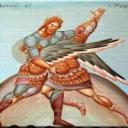Yahoo Answers is shutting down on May 4th, 2021 (Eastern Time) and beginning April 20th, 2021 (Eastern Time) the Yahoo Answers website will be in read-only mode. There will be no changes to other Yahoo properties or services, or your Yahoo account. You can find more information about the Yahoo Answers shutdown and how to download your data on this help page.
Trending News
On decodifying martial arts forms?
Do you take into consideration, how many times and when a movement is used, the sequence of movements if applicable some times, do you just take the movements and find practical applications, do you just stay mainly with what you were taught, do you apply also the concepts or principles of your art in finding practical applications, something in between or something different.?
Thanks in advance for all the answers and feel free to elaborate:)
I do realize that this may be a difficult question, but since everyone at some stage does this, I guess perhaps some good answers are to be come out of this question.
10 Answers
- pugpaws2Lv 77 years agoFavorite Answer
Several things that may help you with Bunkai.
1) Kata are not about fighting multiple attackers.
2) There are no blocks in the movements. All moves that appear to be blocking are striking or doing something else.
3) Each movement has more than one way of being used.
4) Each stance is not a static (non moving) position. Stances are actually techniques that are used to shift weight while doing something with your hands.
5) When both hands are moving pay attention to the hand that is closest to your body. The rear hand is doing something that makes what the forward hand is doing work better.
6) Look at each movement and stance for the ways it can be used against one attacker. An example is when you see what looks like blocking two attackers at the same time. Say one arm is doing a high block and the other a low block on the opposite of your body. There is only one attacker and the bunkai involves the use of both hands in dealing with that one attacker.
7) When a mover repeats three times it is telling you that the technique can be applied to either side of the attackers body, But that it is sometimes more effective if applied to the attacker right side. (Example: many Kata have a set of three steps forward while executing three punches. Notice that you will always do two right punches but one one left punch)
8) We tend to think that all moves in a kata are things that we would do in some situation. While that is often true, sometimes the movements we are doing are not moves we would do but simulate an attack that we might have come at us. In those cases the defensive applications are also in the Kata.
9) When we do any technique that ends with one of our hands touching our other arm at some place (at the wrist, elbow, ...etc.) The bunkai is that you are doing a technique that requires that you strike, grab. or brush the attacker at that place. (Example: in many Kata there is a step forward while doing what appears to be a spearhand straight in front of you ending with the other arm level with the floor elbow bent 90 degrees and the tips of the fingers. or the hand itself touching the elbow of the thrusting hand. The hand touching your elbow is actually deflecting a punch while, the thrusting hand is doing either a spearhand or striking up under the attackers elbow to strike a nerve/pressure point.)
Edit: I find it curious that I have several thumbs down. Tells me a lot about the type of person that would give me one for what I stated here. Sad, really sad...
- LiondancerLv 77 years ago
I definitely consider the sequence of movements. If there is a movement I do not understand I definitely look at the movement before and/or after that. Since your opponent is not going to just stand there but is also moving and trying to evade your application subsequent movements often give a clue to prevent an escape or having the technique turn against you.
I definitely use the concepts and principles of my art to work on applications. Often other arts give clues to a technique but it does not quite fit into your flow of movements. I try to make them work with what I already have and the flow of movements which is taught through kata by fitting them into my flow of movements through small adjustments. It is not good to have techniques that widely vary in movement as it would be difficult to adjust to your opponents resistance and switch from one technique to another that varies greatly in the flow.
About the 'how many times a movement is used' has always mystified me a bit. Sometimes it looks like the same movement but there are very small variances in the emphasis. So not so sure about this one.
- jwbulldogsLv 77 years ago
When breaking down the applications in kata there is more than one way to look it it. You can do this in sequence. You know what comes before and what is happening afterwards. However, it is not to be thought of in as totally sequence. Each technique is a fight within itself. It doesn't just have to follow a patter of movements. Each technique can and should be used to end the threat.
When doing sequence it is a flow drill you are working. But when not doing sequence you are doing a different drill. It can be tuite. It can be throwing. It can be choking. It can be a variety of thing. There is not enough time to cover this on here. We have many teachers. After years of study you will learn these technique are in other arts. Other instructors may teach different applications for the same techniques. This gives you the opportunity to do it in a variety of ways and see thing that you didn't see and add them to what you do.
- callsignfuzzyLv 77 years ago
Do you mean "decoding"? To codify is to organize.
Different systems use forms for different purposes, or at least seem to organize them differently. For example, Wing Chun's Sui Nim Tao is very much like an alphabet- this is how we do Tan Sau, this is how we do Bong Sau, etc. Similarly, the WTF's Taegeuk forms appear to be little more than progressively more complex movements of blocks and strikes; nothing overly complicated or unexplained is going on. Contrast that with so-called higher level forms in Okinawan, Korean, Indonesian, and Chinese martial arts, where some movements have no obvious meaning.
I've read articles by people who insist that a single movement can have multiple meanings. OK, I guess it CAN, but my belief is that the creator of a form wanted a movement to have a specific meaning. I think most of those meanings have probably been lost to the ages, due to mistranslations, poor imitation, secrecy, and so on. I think if we're going to be doing archaeology on these forms, if you will, we need some context. Were these movements designed to deal with a rival school's techniques? Were the common attacks 200 years ago in China the common attacks we see today?
Ultimately, when there's no obvious meaning to a movement, I try to run down the so-called Habitual Acts of Violence. I also look at preceding and anteceding movements to try to get some context. THEN I try to find out more about historical context, though I'm usually at a loss there. When it comes to karate forms, many movements have subtle shifts in performance between systems, so I like to compare how different systems perform the same sequence.
It really hasn't been a focus of mine lately, though. Guesswork is fun, but I know working variations of the guillotine choke, for example, will pay dividends immediately, compared to spending weeks trying to figure out what one movement MIGHT be for.
- How do you think about the answers? You can sign in to vote the answer.
- Mild MaxLv 47 years ago
Pug, I gave you an extra one just because you said it was curious, I love detective novels so I figured I'd throw a new player into the mystery - I say it was the maid with the candlebra.
Back to Georgie - I love pulling my kata apart, just to see if I can figure out the why of movements and sequences then give my theories a testing in sparring, problem is I often wind up getting stuck and confused when I go back to practicing them in their own kata because I'll also find other sequences from other kata blending just as well so I get limited by my inability to burn the kata into my mind to the point where I can keep it seperate from what just flows.
- DarrenLv 77 years ago
Some movements can be interpreted as individual movement and others are effective in the set sequence. Some moves can be interpreted and applied in multiple applications. The more you scrutinize over your forms the more you will discover the mysteries which they contain. I feel that many practitioners do not spend enough time discovering what secrets are available to them if they just take the time to study them.
- 7 years ago
I take into consideration all those questions a little bit, but the most I get from forms is how it keeps my techniques maintained and gives me a flow. It makes me sweat and strengthens my stances, controls my breathing, and when people do it together well, it's very impressive.
Source(s): MA - KokoroLv 77 years ago
yes to all of the above. it would be eaier to wright a book on this subject then to answer the question in yahoo. i don think there is any hard set rules that apply s to all bunkai,
for me, the application must work for me, it must be a technique i can pull off. it is worthless to me if i cant pull it off when i need it. someone may show me a valid application but i might not be able to use it, it doesn't mean there application is useless, its just something i cant be applied to my needs.
when i look for an application i start with apply it to various situations of how a fight would start, (a grab, push or shove, hay-makers, straight punches, locks, etc.). and i look at how the application would unfold from that point on.
many times i do take ideas from others, i will often change them to fit me more easily,
as for the repetitive ff techniques, there are several ways you can look at it. it can be part of kyushu jitsu where you are striking the same point of those reasons, it can be the opponents positions is changing and your utilizing the same technique for different scenarios, there is a few other reasons that i cant think of at this time.
Source(s): 30+yrs ma - possumLv 77 years ago
Yes, I do consider all of them. Sequence, repetition, rhythm, speed, eyeline, points of balance, strength - they are all important elements in trying to determine what is being taught by the form. This is one of the key reasons why just watching a youtube clip of a "how to do this form" is useless without the adjunct learning and experiencing what the techniques are supposed to do.
But there are things that forms do not teach us, and when I realize what those things are, I begin to rethink what I've been taught. For example, forms would have us thinking that self-defense is a neat and clean event: opponent is here, you are there, he does this, you do that, and it's over. You win. Of course, life isn't like that, and a sequence of movements may be called for in a form, but, to pull if off may first require some intermediate foot- or handwork and maneuvering depending on your position, your skill, and your opponent's skill.
Too often, people have this idea that a form should be used in self-defense. This ignorant thinking came about by watching too many Saturday afternoon b-rated Kung Fu movies out of 1970's Hong Kong.
I think that sequences of movements should be short - no more than 2 or 3 movements, because after that, your opponent can move or counter in ways that are not represented in a particular form (but which might be addressed in another form). So the more atomic the movement is, the more room you have to think about it's uses and not have to worry about what the opponent will do.
- BonLv 67 years ago
Forms are the basis of all your techniques. It is the foundation on which you build on. To build on it, you have to dissect it and understand why and how things are done the way they are. They are your ABC's from which you construct the words from which you form sentences and with which you create a thesis for your thoughts. Just as the ultimate aim of the alphabet is to convey or express your thoughts, the ultimate aim of forms/kata is to "express" physically your responses to a given situation. And to do this, one must go beyond just what is taught.
You do not learn a language simply by memorize every sentences in existence. You do not learn a martial art by memorizing every move possible for any situation; in the beginning you have to learn some of the basics, then advance to more complex technique, but the ultimate goal is to be free from patterns just as you can converse freely with someone without having to recall every sentence you have ever learned. You simply do it freely - on the fly so to speak.








